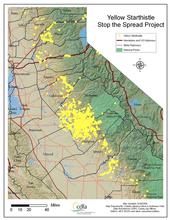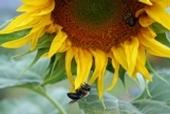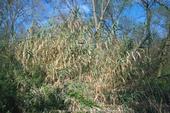- Author: Rebecca Miller-Cripps

Weeds, weeds, weeds! Have you noticed? This has been a banner year for weeds. Puncturevine where I’ve never seen it before. Garden soil covered with common purslane (at least it’s good in salads). And solid stands of yellow starthistle everywhere!
Our cool late spring and repeated late rains created multiple germination periods; weed seeds in the soil had many opportunities to sprout. And sprout they did! With the heat of summer, weeds flowered and became noticeable. Now, weeds have set seed and...
- Author: Ann King Filmer

All bets are off in terms of what will happen with plant species migration and crop production as the climate changes globally.
A common assumption has been that native plants and animals would “move,” or migrate, to higher elevations as temperatures rise, to maintain their “preferred” temperatures, but a new report by Jonathan Greenberg at UC Davis, shows that many California plant species moved downhill over the past 70 years.
According to Greenberg, “While the climate warmed significantly in this period, there was also more precipitation. These wetter conditions are allowing plants to exist in warmer locations than they were previously capable...
- Author: Pamela Kan-Rice

When the great outdoors is your research laboratory, gathering data can be a challenge. To get a broader perspective on the extent of damage caused by sudden oak death, a UC Berkeley Cooperative Extension geographer is using crowd sourcing to enhance her research on the disease that has killed over a million of California’s iconic oak trees since 1995.
Maggi Kelly, UC Berkeley Cooperative Extension specialist, started collecting data from community members through her OakMapper website in 2001. Now she has a mobile application for smartphones.
While out in a park or forest, iPhone users can use the new OakMapper mobile app to report...
- Author: Chris M. Webb

Invasive weeds can be very problematic, affecting agricultural productivity, public health, natural resource biodiversity; increasing the risk and severity of wildfire; and reducing water quality and quantity.
A nationwide program designed to map invasive weed locations online was started at the University of Georgia in 2005. What’s Invasive! Community Data Collection provides a way for people to map invasive weeds they see while visiting national parks.
The U.S. Forest Service is instantly alerted to the location of habitat-destroying species. This information is useful for increasing knowledge about the location and...
- Author: Chris M. Webb

In the early 1800s, European immigrants introduced the fast-growing giant reed arundo (Arundo donax) into California to use the canes for musical instruments. The plants were also used for erosion control and the reeds used for thatched roofing. However, it has since naturalized and become a serious pest in the state's natural waterways.
Arundo can grow at a rate of four inches per day and can reach heights of 30 feet. It reproduces and spreads when sections of the stem or root break off and float downstream.
Dense stands of arundo displace native riparian species. The plant requires a significant amount of water, reducing fish, wildlife and people. In addition, clumps of arundo and the soil around their roots...



